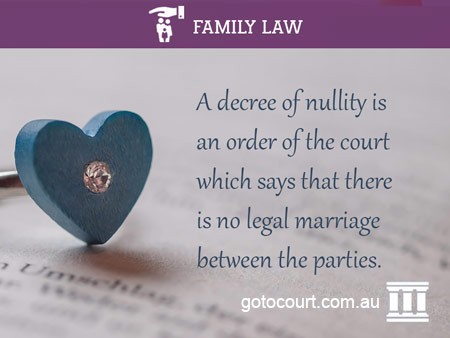How To Get A Marriage Annulled
Call our lawyers NOW or,
have our lawyers CALL YOU
Annulment of Marriage
What is an Annulment of Marriage?
An annulment of marriage in Australia is governed by the Family Law Act and requires a decree of nullity.
A decree of nullity is an order which says that there is no legal marriage between the parties even though a marriage ceremony may have taken place. It is a finding that the marriage was void.
An application can be made to the Family Court for an order. There is no requirement that the parties be separated for any length of time.

If the decree of nullity is granted by the Court, it is effective immediately. A decree of nullity does not encompass parenting or financial matters, and legal advice should be sought in regard to those issues. An application for the division of property must be done within 12 months of the date of the annulment.
To be eligible to apply for a decree of nullity in Australia to effect an annulment of marriage, at least one of the parties must either:
- be an Australian citizen
- live in Australia and consider Australia to be their permanent home, or
- ordinarily live in Australia and have done so for at least 12 months before the application.
An annulment can only be granted in limited circumstances. If those circumstances do not apply, then the parties will need to be separated for 12 months and apply for a divorce if they wish to end the marriage.
A decree of nullity giving rise to an annulment of marriage is an order of the court which says that there is no legal marriage between the parties.
Grounds for annulment
The Court may only annul the marriage on the following grounds:
- One of the parties was still validly married to someone else at the time of the marriage.
- The parties are in a prohibited relationship. Marriage may not take place between direct descendants (such as parent or grandparent and child) or siblings (including half-siblings) including adopted (by law) relationships.
- The parties did not comply with the laws in relation to the marriage in the place they were married, such as using a celebrant not authorised to perform marriages.
- One or both of the parties was not old enough to marry.
- One of the parties did not give their real consent to the marriage. This could be because their consent was obtained by duress or fraud, or because one party was mistaken as to the identity of the person that they were marrying or did not realise that they were being married or where one party was mentally incapable of understanding the nature and the effect of the marriage ceremony.
Applying for Annulment
An application for a decree of nullity must be filed using an Initiating Application form. Three copies of the completed Initiating Application form must be filed, with a copy of the marriage certificate and an affidavit stating the facts relied on for the annulment of the marriage, and details of the kind of marriage ceremony that was performed.
There is a filing fee for an application for a decree of nullity which is currently $1,195.00. In some cases a reduced fee may be sought if the party filing the application holds certain government concession cards or can demonstrate financial hardship.
To commence the application for the annulment of marriage, the applicant has to serve the papers on the respondent to the application. The documents must be given personally to the other person by someone other than the applicant (or placed on the ground after telling them what it is if they refuse to take it), on their lawyer, or by post or electronic transmission (the receiver will need to sign an acknowledgment of service in this case). With the application, a copy of the court pamphlet on Marriage, Families and Separation, an Affidavit of Service form and an Acknowledgment of Service form must also be served.
If the other party wishes to contest the application, a Response to Initiating Application form must be filed. This must be supported by an affidavit setting out any facts they rely upon in opposing the application or if they say that the Family Court does not have the jurisdiction to hear the application.
If the respondent is in Australia, a hearing date that is within 42 days of the application will be set. If the respondent isn't in Australia, that hearing date will be at least 56 days after the application was made.
Annulment by the Catholic Church
The Catholic Church does not recognise the re-marriage of a divorced person while the first partner is still living. It also does not recognise the marriage of a single person to someone who has been divorced. No divorced person can marry again in the Catholic Church unless the Tribunal annuls the marriage.
Church law about the annulment of marriage can sometimes be complex and specialist advice may be required. Having an annulment granted by the Church is not recognised by the law as a legal annulment of the marriage and it is still necessary for the parties to legally end the marriage before remarrying.
Call our lawyers NOW or,
have our lawyers CALL YOU
1300 636 846
7am to midnight, 7 days
How To Get A Marriage Annulled
Source: https://www.gotocourt.com.au/family-law/annulment-of-marriage/
Posted by: gobeilrappy1958.blogspot.com

0 Response to "How To Get A Marriage Annulled"
Post a Comment